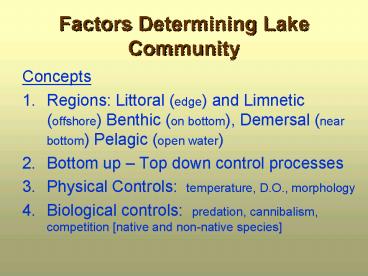Factors Determining Lake Community - PowerPoint PPT Presentation
1 / 26
Title:
Factors Determining Lake Community
Description:
Crayfish per trap. Snails per sq. meter. Total crayfish abundance increased but the two native species were replaced by rusty crayfish ... – PowerPoint PPT presentation
Number of Views:94
Avg rating:3.0/5.0
Title: Factors Determining Lake Community
1
Factors Determining Lake Community
- Concepts
- Regions Littoral (edge) and Limnetic (offshore)
Benthic (on bottom), Demersal (near bottom)
Pelagic (open water) - Bottom up Top down control processes
- Physical Controls temperature, D.O., morphology
- Biological controls predation, cannibalism,
competition native and non-native species
2
- Generalized Littoral Community
Piscivores
Fish
Invertebrate predators
Grazers
Periphyton
Macrophytes
Sediment
3
- Generalized Limnetic Community
Piscivore
Invertebrate Planktivore
Planktivorous Fish
Crustacean Zooplankton
Phytoplankton
PO4 NH4
4
Bottom-up vs. top-down control
Tertiary consumer Secondary consumer Primary
consumer Producer Nutrients
5
Bottom-up controls
0 2 3 4 5 6 8 10
Smolt weight (g)
0 0.4 1.0 1.6 2.2 2.8
log fish crop
0 1.0 2.0 3.0
0 1 5 10 20 30
60
Zooplankton per fish (g)
Log total phosphorous
Relation between (July Sept) zooplankton
biomass per fish in study lakes and sockeye
salmon size (Hyatt and Stockner, CJFAS 1985).
Relationship between average total phosphorous
and fish standing crop (Stockner 1987)
6
Lake communities bottom-up vs. top-down control
Mean weights of underyearling sockeye salmon vs.
the relative density of parent spawners
- Lake ecology of sockeye salmon
- Sockeye growth is limited by zooplankton
- Zooplankton rely on phytoplankton
- Nutrients limit phytoplankton
Weight (g)
So, do nutrients limit sockeye growth?
Density (Thousands per km2 of lake area) Burgner
1987
7
Bottom up control of British Columbia coastal
lakes fertilized with N and P
8
- Effects of Fertilization on Zooplankton and
- Sockeye Salmon Growth and Development
Pre-Fertilization
Post-Fertilization
Packers Lake, AK Koening and Burkett 1987
9
Lake communities Top down vs. bottom-up control
- Long standing view
- Abundance, species, and size distribution of
zooplankton and intermediate trophic levels
controlled by nutrients and primary production - Brooks and Dodson (1965) investigated small New
England lakes, revealing that fish often
structure the zooplankton
Daphnia
Alewife (Alosa pseudoharengus)
10
Lake communities Top down vs. bottom-up control
Brooks and Dodson 1965. Science 150 28-35
11
Lake communities bottom-up vs. top-down control
- Density-dependent growth and development of
sockeye salmon
Fry stocked into Leisure Lake, AK (Koenings and
Burkett 1987)
12
Alternative lake communities
Wisconsin Lakes
Tonn and Magnuson 1982 Ecology
13
Alternative lake communities
lake trout (Salvelinus namaycush)
B Few Many, Fast-growing Few Large
A Many Few, slow growing Many Small
cisco, lake herring (Coregonus artedii)
Mysis relicta
Zooplankton
14
Species Introductions
How can the introduction of prey depress the
abundance of the predator?
Rainbow smelt (Osmerus mordax)
Introduced 200 mm long
Walleye (Stizostedoin vitreum)
Declined 600 mm long
Lake whitefish (Coregonus clupeaformis)
Declined 500 mm long
15
Species Introduction
northern pike (Esox lucius)
99
yellow perch (Perca flavescens)
largemouth bass (Micropterus salmoides)
90
Bluegill sunfish (Lepomis macrochirus)
90
16
Species Introduction
- Eradication Attempt Hemming Lake, Minnesota
northern pike (Esox lucius)
Tried unsuccessfully to eradicate pike for 15
years to control Triaenophorus crassus parasite
The Hemming lake case history illustrates that
when habitat is available, intensive removal may
not eliminate the species but only initiate a
compensatory response resulting in faster
turnover of the population Colby et al. 1987
Lake whitefish (Coregonus clupeaformis)
17
Invasion of Trout Lake, Wisconsin by rusty
crayfish (Orconectes rusticus), and effects on
the community Wilson et al. 2004. Can. J. Fish.
Aquat. Sci. 61 2255-266.
18
Macrophyte diversity declined with crayfish
abundance
20
Mechanism consumption and non-consumptive
destruction while foraging
15
Number of macrophyte species
10
5
0
0
10
20
30
40
50
60
70
Crayfish per trap
19
Abundance of snails on sandy sediments declined
with rusty crayfish abundance mechanism
predation
70
10,000
60
50
1,000
Crayfish per trap
40
Snails per sq. meter
30
100
20
10
10
10
1985
1980
2000
1990
1995
20
Total crayfish abundance increased but the two
native species were replaced by rusty crayfish
3 species combined
O. rusticus
O. propinquus O. virilis
21
Species Introduction
Flathead River-Lake ecosystem emphasizing
components affected by the introduction of
opossum shrimp
22
Species Introduction
Spencer et al. 1991 BioScience 4114-21
23
Species Introduction
24
Multiple Equilibria Yellow Perch
A
A1
B1
B
Wilson Lake
1954
1984
Grace Lake
1980
1948
Stable, high stock of large perch sustained by
discovery, including connibalism. A1 is
unstable. Depensatory mortality can drive the
stock down. At lower equilibrium B1 the stock is
too small to exert depensatory predation.
25
Lake communities Physical Factors
- Light latitude, ice, 10 production
- Temperature latitude, depth, wind, flow
- Dissolved Oxygen
- All affect type and rate of biological production
processes
frozen lake
26
Life history of fathead minnows at lakes
differing in winterkill probability (density and
coefficient of variation)
75 65 55 45 35 25
3
0.14/m (93.5)
3
0.72/m (56.9)
3
1.92/m (22.8)
Length (mm)
3
3.75/m (33.6)
1 2 3 4 5
Age (years)
Danylchuk and Tonn 2006































